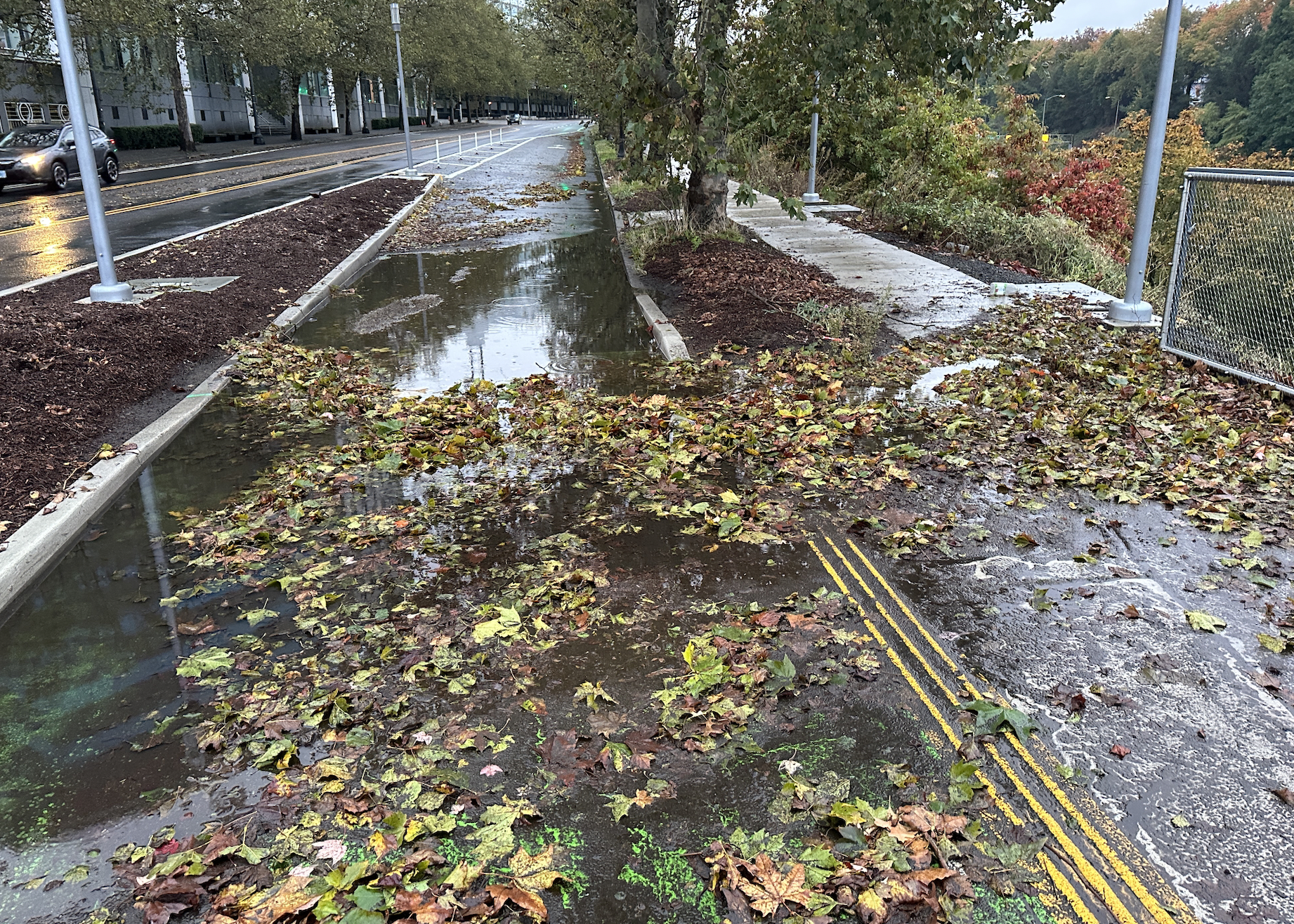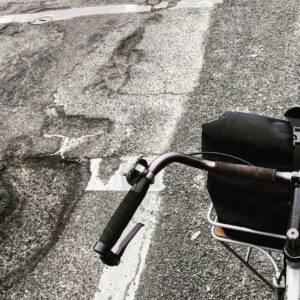After months of desert-dry weather, the tide has turned in Portland and we got a few big soakings in the last few weeks. We need the rain, but for people who bike around the city, wet weather comes with caveats.
There’s a lot you can do to keep relatively comfortable while biking in the rain. For the first time in all my years as an Oregonian I actually have the gear needed to comfortably exist outside in the winter (thanks to Portland-based Showers Pass for suiting me up, and stay tuned for a product review!). Good outerwear, shoes and bike fenders go a long way to make riding in the rain more palatable. But even the best rain outfit can’t solve every puddle problem.
Bikeway maintenance proves tricky enough for the city to keep up with throughout the whole year. In the fall and winter, however, conditions get really rough. Portland’s stunning autumn leaves give our streets a beautiful yellow and orange carpet, but when big fall rainstorms meet piles of leaves, things can get messy. The debris clogs up the storm drains, forming puddles on the sides of the street – often right where the bike lanes are.
The Portland Bureau of Transportation is in charge of cleaning storm drains, but with everything else the maintenance crew is tasked to do this important job can get pushed to the side. Therefore, PBOT relies on community volunteers to keep storm drains clean. They even have a program encouraging Portlanders to “adopt a storm drain” because while “PBOT crews work hard to keep more than 58,000 storm drains clear,” they can’t get to them all.
“If drains get clogged with fallen leaves and other debris, it can lead to dangerous ponding along city streets and intersections. That’s why we’re asking Portlanders to adopt storm drains in their neighborhoods to keep them free and clear of leaves,” a recent PBOT news release states.
I am happy to help out and volunteer to make our bike lanes usable, but it bears mentioning that people who drive cars are not expected to spend time and energy fixing the streets so they can drive on them.
There are several areas around the city that are known to pool up during winter. One place that’s gained notoriety this fall is the bike lane on the northeast side of the new carfree Blumenauer Bridge in the Lloyd District. Despite all the fancy new bike infrastructure adjacent to the bridge, there’s a spot in the bike lane that has been a magnet for water to pool up at quite impressive depths (leading some people to name it ‘Lake Blumenauer’).
It’s ironic to see this beautiful new bridge and infrastructure tarnished by something as seemingly small as leaves stuck in the storm drains. But it just shows what can happen when routine maintenance is overlooked.
So, what can we do? It may be worth asking why PBOT is in charge of all the storm drains when the Bureau of Environmental Services (BES) handles other storm runoff and has had the capacity to create a truly remarkable residential rain garden program. On a Pedalpalooza ride this summer, PBOT and BES staffers admitted the bureaus haven’t always been able to work together to fix problems like this.
Something’s gotta’ give. Bikeway maintenance is a persistent problem in Portland and a sure way to throw cold water on our cycling goals is to make people ride through puddles of it.
For more puddle content, don’t miss our video of Jonathan riding through the atmospheric river!








Thanks for reading.
BikePortland has served this community with independent community journalism since 2005. We rely on subscriptions from readers like you to survive. Your financial support is vital in keeping this valuable resource alive and well.
Please subscribe today to strengthen and expand our work.
I hit Lake Blumenauer at full speed during the deluge last week — hilarity ensued. Is there really a drain there to be unclogged? We’ll have to wait until next July to find out. Stay tuned.
Someone needs to hold PBOT to a higher standard when they design and build things. I know consultants often do the design, and construction is contracted out, but PBOT has frequent review during the design phases and their is a dedicated PBOT employee involved with each construction project. There are so many recent examples of truly, objectively BAD design, and terrible construction mistakes that are simply ignored and signed off on by PBOT. I don’t know who would audit them, but it clearly needs to happen. PBOT was once an impressive bureaucracy with knowledgeable, diligent staff, now it is not.
For illustration: the better Naito project deficiencies:
WHY was the path depressed two vertical curbs? (Any idea?)
Yes, this is a poor design issue…were future operations and maintenance practices may be given too little thought in the design phase, especially for new (vs retrofit) construction AND plus bike facilities tend to get less wheel friction ‘benefit’ for masticating leaves that a typical vehicle lane…plus drivers are protected from mud splash…and these facilities tend to not get as much attention by the street sweepers due to lack of time budgeted and lack of mechanical equipment / requirement for more manual hand sweeping…
Count me in as someone else who is not impressed. I don’t use that particular facility (Naito) but I recognize the design/construction issues as systemic and ingrained at PBOT, hence the similar problems with Lake Blumenauer. It goes right along with the ‘greenways’ having the worst pavement and grades, all kinds of weird ‘experimental’ designs for bike infra, curb extensions screwing up drainage and eliminating opportunities for new bike facilities, generally overengineered bike infra on already safe secondary streets and on far-out arterials which no one ever bikes on, while inner city arterials desperately in need of bike facilities are ignored.
And if you need a prime example of what’s wrong with PBOT’s planning and design, an ideal candidate is one of the only bike infra projects on an inner city arterial, the so-called parking protected bike lanes on lower SE Hawthorne. Hardly anyone uses this facility b/c it feels and is unsafe at multiple levels, and goes nowhere since it ends at 12th instead of continuing up to the business district and beyond.
On top of all this, add in the lack of all kinds of routine maintenance, from sweeping to pavement maintenance to drainage management, and Portland’s rating as a bike city these days is Lead, and nowhere near Platinum, Gold or Silver.
There are some cities that actually sweep their streets more than twice a year.
And some of those cities actually make you move your car or tow it so that sweeping is done fully and efficiently. Wild.
They finally swept outer Holgate this week. It had been since at least July when it was done last, but likely even longer ago than that. It was the last day or two of July or first day or two of August that a parked car window was smashed and some ceramic tiles (?) had fallen out of a truck or something and become rubble in the bike lane. “Ok, it’s the start of August, I wonder when this will get swept if I don’t report it”.
PBOT won’t even tell you when they’re sweeping if you ask.
So true. They absolutely refuse to be held accountable for the quality of their work.
It’s fall in the Northwest. Portlanders have always helped to clear drains, Bud Clark used to go out and clear drain in NW while he was Mayor.
PBOT is pretty fast at cleaning out storm drains if you use the PDXReporter.org interface.
It only takes a minute to report, and they always respond within 24 hours.
Sure, it’s a lame and lazy management system that doesn’t do routine audits of infrastructure. But, at least they offer a functional workaround.
I’ve reported about 20 plugged storm drains in the last week. All of the ones I’ve revisited have been cleaned.
Ted Buehler
“ we’re asking Portlanders to adopt storm drains in their neighborhoods to keep them free and clear of leaves,”
Note that the general public *shouldn’t* be out in the travel lanes on busy roads.
PBOT should really add material in their news release asking people to use PDXReporter or another city reporting system to inform the city of plugged drains *outside* of their neighborhoods.
Ted Buehler
This winter is forecast to be a moderate la Niña, with some snow already at medium elevations. We could see the conditions that show up the worst case of bike infrastructure maintenance — snow stored in the areas supposedly designed for bikes and pedestrians.
Almost without exception snow management results in curb cuts blocked with a deep ridge of snow, slush and debris. This mess is potentially armor plated with ice if temperatures drop.
I can ride through quite a bit of water if it comes to it but a person who depends on a mobility device is out of luck when they encounter a blocked curb cut. In this city a person using a chair might be homebound for days.
Tell me! I used to walk around a lot. I cannot tell you the number of times I flipped over my walker on a messed up curb cut, and fell into a hidden puddle up to my knees.
This is a problem that is, unfortunately, not unique to Portland; many cities that get a lot more frozen precip have the same issues.
“this important job can get pushed to the side.”
An illustration of this — MLK Blvd is a bust arterial for commuter cars, transit and trucking. It’s the old Pacific Highway East — state route 99E.
If a city is going to do routine maintenance on their roadway system, it would logically stand that these types of core roadways would be at the receiving end of a city’s best maintenance.
On Christmas Day and New Years Day 2021/2022 I walked the length on MLK Blvd, from the SE Market St to the Columbia Slough. Up one side, down the other.
I turned in every clogged storm drain.
Of the ~300 storm drains, about 100 were at least 75% clogged. And about 30 were completely filled with gravel. Not allowing any water to drain. Obviously hadn’t been cleaned in years. Maybe decades.
Before I did this project, driving on MLK in the rain was like driving through a splash pad at a playground. The roadway was just covered in an inch of water in many areas, and traffic would just result in constant sprays of water every which way.
PBOT dutifully cleaned out each storm drain, and afterwards driving became a lot easier, with much less standing water on the road.
Anyhow, that is the city’s “best of the best” maintenance program.
For bikeways, it is relatively easy for us bicycle-riding folks to turn in plugged storm drains, and keep the bikeway system reliably well drained. Because we are on the ground, we can stop easily and send in a report or snap a photo, and we are motivated because it is more than our fenders and windshields that get splashed.
And. If we want the city’s maintenance budget to have justification to add a “routine audit of storm drains” to their schedule, having hundreds of reports every year will bolster the mid-level managers’ ability to get a larger budget allocation.
Ted Buehler
Forget hundreds in reports every year, we should be having hundreds of reports every week.
I tip my hat to you, Ted. But no citizen should have to do that level of reporting. We need professional managers who will ensure that staff have the capacity to do important work. Maybe we’ll have them soon – since the charter revision passed!
“PBOT crews work hard to keep more than 58,000 storm drains clear.”
Yeah – right. About ten years ago I saw a guy digging out one of the useless “bubbler” storm drains in my neighborhood. I’ve never seen anyone doing anything to maintain the storm drains on any kind of regular basis. The street sweeper comes through the neighborhood once in a blue moon.
No – PBOT crews may be working hard at something, but they are not working hard to keep storm drains clear.
If you complain enough they send out the vactor truck to suck all the crap out of the drains, the vactor truck is complete overkill, and last time they did the drains in my neighborhood with it, I still had to go out and clean the rest of the debris out by hand, they left like 50% +/- behind.
Really? Where?